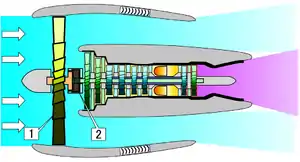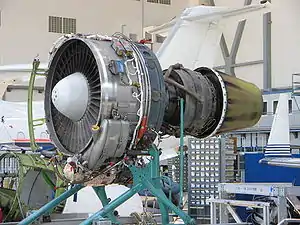Geared turbofan
The geared turbofan is a type of turbofan aircraft engine, with a gearbox between the fan and the low pressure shaft to spin each at optimum angular velocities.
| Geared turbofan | |
|---|---|
 | |
| Geared turbofan. [1]: Fan. [2]: Gearbox. |
Technology
In a conventional turbofan, a single shaft (the "low-pressure" or LP shaft) connects the fan, the low-pressure compressor and the low-pressure turbine (a second concentric shaft connects the high-pressure compressor and high-pressure turbine). In this configuration, the maximum tip speed for the larger radius fan limits the rotational speed for the LP shaft and thus the LP compressor and turbine. At high bypass ratios (and thus high radius ratios) the tip speeds of the LP turbine and LP compressor must be relatively low, which means extra compressor and turbine stages are required to keep the average stage loadings and, therefore, overall component efficiencies to an acceptable level.
In a geared turbofan, a planetary reduction gearbox between the fan and the LP shaft allows the latter to run at a higher rotational speed thus enabling fewer stages to be used in both the LP turbine and the LP compressor, increasing efficiency and reducing weight. However, some energy will be lost as heat in the gear mechanism and weight saved on turbine and compressor stages is partly offset by that of the gearbox. There are manufacturing cost and reliability implications as well.
The lower fan speed allows higher bypass ratios, leading to reduced fuel consumption and much reduced noise. The BAe 146 is fitted with geared turbofans and is still one of the quietest commercial aircraft.[1] A large part of the noise reduction is due to reduced fan tip speeds. In conventional turbofans the fan tips exceed the speed of sound causing a characteristic drone, requiring sound deadening. Geared turbofans operate the fan at sufficiently low rotational speed to avoid supersonic tip speeds.[2]
After considering a geared design, General Electric avoided it for its CFM LEAP among weight and reliability concerns, postponing its use for a future application, after Pratt & Whitney began development of the geared PW1000G.[3]
Engines

Tentatives
- Rolls-Royce/SNECMA M45SD, a derivative of Rolls-Royce/SNECMA M45H turbofan, designed to demonstrate ultra-quiet engine technologies, needed for STOL aircraft operating from city centre airports
- IAE SuperFan, an IAE V2500 derivative proposed for the Airbus A340 between 1987 and 1992
- Aviadvigatel PD-18R, a derivative of the gearless PD-14, based on its high-temperature core, to be completed by 2020
References
| Wikimedia Commons has media related to Geared turbofan. |
Notes
- "More Efficient Jet Engine Gets in Gear". TechnologyReview.com.
- "Buzz-Saw Noise & Nonlinear Acoustics | Engineering and the Environment | University of Southampton". www.southampton.ac.uk. University of Southampton. Retrieved 27 October 2017.
- Lewis Krauskopf (Sep 15, 2014). "GE exec says avoided geared design in jet engine battle with Pratt". Reuters.
Bibliography
- Connors, Jack (2010). The Engines of Pratt & Whitney: A Technical History. Reston. Virginia: American Institute of Aeronautics and Astronautics. ISBN 978-1-60086-711-8.
- Francillon, René J. McDonnell Douglas Aircraft since 1920. London: Putnam, 1979. ISBN 0-370-00050-1.
- Gunston, Bill (2006). World Encyclopedia of Aero Engines, 5th Edition. Phoenix Mill, Gloucestershire, England, UK: Sutton Publishing Limited. ISBN 0-7509-4479-X.